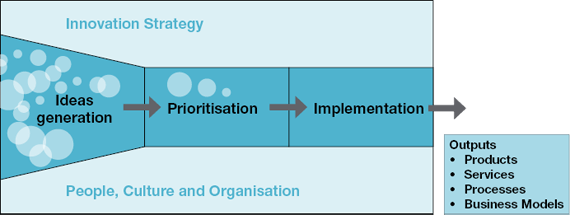Can a PMO structure support the innovation process?
Dr Costas Chryssou
February 14, 2022
tamegon Innovation and Growth Advisory Firm
Today’s competitive global environment is forcing businesses to be more flexible, responsive to change and efficient than ever before. Gaining and sustaining competitive advantage is one of the biggest priorities and challenges that all organisations, in both private and public sectors, face.
Innovation, "...the process of translating an idea or invention into a good or service that creates value or for which customers will pay…" is frequently seen as a tool to deliver and maintain an organisation’s competitive advantage

Experience shows that innovation, and particularly disruptive innovation, presents many challenges to organisations. Studies, conducted by Harvard Business School, show that a large percentage (70 – 90%) [1] of innovation products fail. Most organisations, over time, develop robust systems, processes and cultures suited to ‘steady-state’ operating conditions. High-risk discontinuous innovation projects do not fit well with the ‘traditional’ stage gate approaches to innovation, rendering their approaches unsuitable.
But why is innovation so hard to do well?

Keith Goffin, of Cranfield School of Management, describes the innovation value chain as comprising the steps of ideation, project prioritisation, implementation and commercialisation (Innovation Pentathlon framework) [2]; these aspects are complemented by the organisation’s innovation strategy, culture and organisational structures.
For organisations to be successful in the innovation management process, they need to have the capabilities that will differentiate them from the competition. Studies have confirmed that these capabilities include:
- the ability to scan at the periphery with the view to identify emerging technologies and trends
- the development of ‘fuzzy front end’ approaches to include the seed funding of new innovative and risky projects involving cross-functional teams
- the development and nurturing of inclusive and ‘learning’ organisational cultures.
Based on the above requirements for successfully managing innovation can a PMO structure assist the innovation process in any way? Will the product or service development process benefit from a distinct organisational structure such as an innovation PMO? If yes, what would the innovation PMO look like and what characteristics would it have?
1. The innovation PMO could take a portfolio approach to innovation
Traditionally PMOs tend to focus more on project management planning, establishing methodologies and tools whilst PMOs offering enhanced value to their organisations have extended this focus to include taking a more strategic approach to project management ensuring that the organisation, in addition to ‘doing things right’ does ‘the right things’.
Taking a portfolio approach to innovation, the PMO could ensure that a mixed portfolio of innovation projects is progressing through the technology and product development pipelines; it would ensure that the innovation projects pursued are aligned to overall strategy and that the intended benefits are maximised taking into account investment required, project risk profiles, demand on resources and capabilities and any project interdependencies.
2. The innovation PMO could be involved more in the ‘fuzzy front end’ of the innovation process
The role of the innovation PMO could include creating a ‘sandbox’ for ideation and experimentation to take place in a ‘safe’ environment involving cross-functional teams. The ‘right’ ideas can then be identified and elevated quickly to compete for resources. The innovation PMO working across silos and having responsibility for project resource management can further be a catalyst to accelerating innovation by involving the right people (with the right skills) at the right time. An innovative PMO could also support the organisation's open innovation initiatives taking a pro-active, non-committal, approach exploring beneficial linkages with partners across the value chain, in addition to long-term strategic alliances, becoming an efficient integrator within the organisation.
3. The innovation PMO could become the Centre of Excellence for innovation within the organisation.
The role of the PMO could also include initiatives to make sure that the organisation develops, enhances and maintains critical innovation capabilities nurturing the right organisational culture and establishing best practice. The innovation PMO can capture and disseminate success stories, and can also be the conduit for establishing partnerships across organisational silos and with external partners.
Business strategy drives the need for appropriate capabilities which in turn drive the delivery of a specific portfolio of initiatives. These initiatives include innovation projects which are designed to support the development of products or services linked to gaining and sustaining competitive advantage for the organisation. The innovation PMO can play a vital role as an integrator, supporting and being involved in the innovation management process, especially in the ideation stage, providing effective use of resources and fostering the right cultures.

Costas Chryssou
MBA, PhD
Founder and Managing Director
Sign up for our
articles
Sign up to our newsletter











